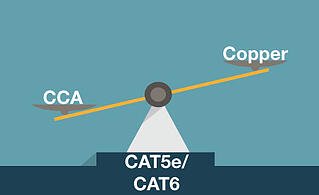CCA Cable: 5 Reasons To Stay Away
CCA Cable Should Be Avoided
When network infrastructure budgets are tight, it can be tempting to cut corners where you can. One way we’re seeing attempted cost savings is through the purchase of copper clad aluminum (CCA) cabling systems. Offered as a cost-effective replacement for solid copper cable, CCA cable is anything but an effective solution.
While CCA products might look like (and be advertised to function like) standard Category 5e or Category 6 cabling, there are major differences that could pose network problems, concerns about business continuity, and safety hazards.
CCA Defined
This type of cable has an inner aluminum conductor coated with copper, and is much lighter than solid copper cables. Because CCA cable is manufactured at a much lower cost, it offers higher profits to manufacturers that sell the product. CCA cabling does have its place when used in certain electrical applications to avoid problems with aluminum wire connections, but it’s not a viable substitute for twisted-pair communications cabling.
5 Network Problems Caused by CCA
There are several notable issues that can arise when using CCA cabling systems as part of your network infrastructure. Here, we outline a few of them for you …
Lack of compliance: CCA twisted pair cables do not comply with UL and TIA standards, which call for solid or stranded copper conductors. CCA twisted pair cables also lack a valid safety listing from the National Electrical Code (NEC). As a result, this type of cabling can’t legally be installed if the building requires CM, CMG, CMX, CMR or CMP rated cables.
Poor flexibility and bend radius: CCA conductors are brittle and break easily; it has been noted that even moving a patch panel or a faceplate can cause failures. Due to low tensile strength, CCA wires may also break off as a result of pulling or shearing, which can occur in packaging or during delivery. It’s also important to note that the bend radius of CCA cabling is limited.
Oxidation and corrosion: Aluminum is very reactive, oxidizing when exposed to air. This may cause failed terminations in the network infrastructure, leading to connectivity problems. Lots of time can be spent locating and addressing these failures.
Not suitable for PoE applications: With much higher DC resistance than copper, conductors may be 60% larger than solid copper to compensate for higher resistance. If not resistance compensated, the voltage drop will be greater for any channel length. Longer lengths (~>65m) will exceed TIA’s channel DCR requirements, limiting the voltage available to the device. Higher resistance causes radiant heat to build up faster, and this may cause damage to the device.
Shorter cable runs: On longer CCA cable runs near the 100-meter maximum, signal strength is reduced as compared to solid copper Category 5e. This can lead to data loss as a result of more packets of data needing to be retransmitted.
How to Identify CCA
 To learn how to recognize CCA cabling, read the tips presented in this previous Belden blog post. To discover which types of twisted-pair communications cabling you should be using as part of your network infrastructure, such as Category 5e, Category 6, and Category 6A, schedule a call with one of our experts!
To learn how to recognize CCA cabling, read the tips presented in this previous Belden blog post. To discover which types of twisted-pair communications cabling you should be using as part of your network infrastructure, such as Category 5e, Category 6, and Category 6A, schedule a call with one of our experts!
